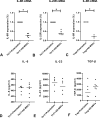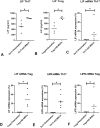Human Adipose Tissue-Derived Mesenchymal Stem Cells in Parkinson's Disease: Inhibition of T Helper 17 Cell Differentiation and Regulation of Immune Balance Towards a Regulatory T Cell Phenotype
- PMID: 32884248
- PMCID: PMC7434526
- DOI: 10.2147/CIA.S259762
Human Adipose Tissue-Derived Mesenchymal Stem Cells in Parkinson's Disease: Inhibition of T Helper 17 Cell Differentiation and Regulation of Immune Balance Towards a Regulatory T Cell Phenotype
Abstract
Background: Parkinson's disease (PD) is a neurodegenerative disorder displaying a typical neuroinflammation pathology that may result from an imbalance between regulatory T cells (Treg) and T helper 17 (Th17) cells. Human adipose tissue-derived mesenchymal stem cells (Ad-MSCs) exert immunomodulatory effects by inhibiting effector T cell responses and have been used to treat diverse immune disorders. We aimed to investigate the modulating effect of human Ad-MSCs on peripheral blood mononuclear cells (PBMCs) of patients with PD, focusing on differentiation into Th17 and Treg cells.
Methods: We isolated human peripheral blood CD4+T cells and co-cultured them with Ad-MSCs at a ratio of 4:1 under either Th17 or Treg cell polarizing conditions for 4 days to detect the proportions of IL-17-producing CD4+T (Th17) and CD4+CD25+Foxp3+regulatory T (Treg) cells by flow cytometry. We also determined the mRNA expression levels of the retinoid-related orphan nuclear receptor (RORγt) transcription factor and those of interleukin-6 receptor (IL-6R), interleukin-23 receptor (IL-23R), leukemia inhibitory factor (LIF), and LIF receptor (LIFR) by quantitative reverse transcription PCR. We detected levels of cytokines in the supernatant (including LIF, IL-6, IL-23, IL-10, and TGF-β) using ELISA.
Results: Our results showed that Ad-MSCs specifically inhibited the differentiation of PBMCs of patients with PD into IL-17-producing CD4+T cells by decreasing expressions of IL-6R, IL-23R, and RORγt (the key transcription factor for Th17 cells). Moreover, Ad-MSCs induced a functional CD4+CD25+Foxp3+T regulatory cell phenotype as evidenced by the secretion of IL-10. The levels of IL-6, IL-23, and TGF-β remained constant after co-culture under either the Th17 or the Treg cell polarizing condition. In addition, levels of LIF protein and its receptor mRNA were significantly increased under both polarizing conditions.
Conclusion: The present in vitro study found that Ad-MSCs from healthy participants were able to correct the imbalance between Th17 and Treg found in PBMCs of PD patients, which were correlated with an increase in LIF secretion and a decrease in expression of IL-6R, IL-23R, and RORγt. These findings should be confirmed by in vivo experiments.
Keywords: CD4+T cell; Parkinson’s disease; T helper 17 cell; T regulatory cell; adipose-derived mesenchymal stem cells; leukemia inhibitory factor; peripheral blood mononuclear cells.
© 2020 Bi et al.
Conflict of interest statement
Dr Xu Zhang reports non-financial support from Wenzhou Medical University First Affiliated Hospital, during the conduct of the study; non-financial support from Wenzhou medical University First Affiliated Hospital, outside the submitted work. The authors declare no other conflicts of interest in this work.
Figures




Similar articles
-
Mesenchymal stem cells generate a CD4+CD25+Foxp3+ regulatory T cell population during the differentiation process of Th1 and Th17 cells.Stem Cell Res Ther. 2013 Jun 4;4(3):65. doi: 10.1186/scrt216. Stem Cell Res Ther. 2013. PMID: 23734780 Free PMC article.
-
The regulation of the Treg/Th17 balance by mesenchymal stem cells in human systemic lupus erythematosus.Cell Mol Immunol. 2017 May;14(5):423-431. doi: 10.1038/cmi.2015.89. Epub 2015 Oct 5. Cell Mol Immunol. 2017. PMID: 26435067 Free PMC article.
-
Inactivation of Notch signaling reverses the Th17/Treg imbalance in cells from patients with immune thrombocytopenia.Lab Invest. 2015 Feb;95(2):157-67. doi: 10.1038/labinvest.2014.142. Epub 2014 Dec 8. Lab Invest. 2015. PMID: 25485537
-
FOXP3 and RORγt: transcriptional regulation of Treg and Th17.Int Immunopharmacol. 2011 May;11(5):536-42. doi: 10.1016/j.intimp.2010.11.008. Epub 2010 Nov 23. Int Immunopharmacol. 2011. PMID: 21081189 Review.
-
The role of T helper 17 (Th17) and regulatory T cells (Treg) in human organ transplantation and autoimmune disease.Clin Exp Immunol. 2007 Apr;148(1):32-46. doi: 10.1111/j.1365-2249.2007.03356.x. Clin Exp Immunol. 2007. PMID: 17328715 Free PMC article. Review.
Cited by
-
Immunomodulatory Functions of Adipose Mesenchymal Stromal/Stem Cell Derived From Donors With Type 2 Diabetes and Obesity on CD4 T Cells.Stem Cells. 2023 May 15;41(5):505-519. doi: 10.1093/stmcls/sxad021. Stem Cells. 2023. PMID: 36945068 Free PMC article.
-
Human Amniotic Fluid Stem Cells Ameliorate Thioglycollate-Induced Peritonitis by Increasing Tregs in Mice.Int J Mol Sci. 2022 Jun 9;23(12):6433. doi: 10.3390/ijms23126433. Int J Mol Sci. 2022. PMID: 35742877 Free PMC article.
-
Adipose-derived stem cells in immune-related skin disease: a review of current research and underlying mechanisms.Stem Cell Res Ther. 2024 Feb 8;15(1):37. doi: 10.1186/s13287-023-03561-8. Stem Cell Res Ther. 2024. PMID: 38331803 Free PMC article. Review.
-
Pathological mechanisms of neuroimmune response and multitarget disease-modifying therapies of mesenchymal stem cells in Parkinson's disease.Stem Cell Res Ther. 2023 Apr 12;14(1):80. doi: 10.1186/s13287-023-03280-0. Stem Cell Res Ther. 2023. PMID: 37041580 Free PMC article. Review.
-
Mesenchymal stem cells as a potential therapeutic tool to cure cognitive impairment caused by neuroinflammation.World J Stem Cells. 2021 Aug 26;13(8):1072-1083. doi: 10.4252/wjsc.v13.i8.1072. World J Stem Cells. 2021. PMID: 34567426 Free PMC article. Review.
References
MeSH terms
Substances
LinkOut - more resources
Full Text Sources
Medical
Research Materials
Miscellaneous

